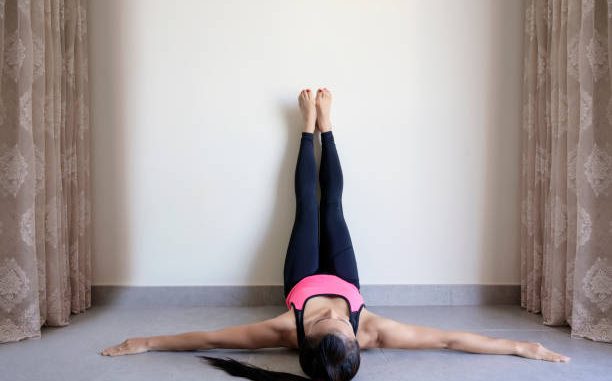
Yoga is a multifaceted practice that offers a wide range of physical and mental benefits. One yoga pose that has gained popularity for its simplicity and potential benefits is Viparita Karani, often referred to as “Legs Up the Wall” pose. This pose involves lying on your back with your legs extended upward against a wall. As someone who incorporated this daily practice into my routine, I’d like to share five valuable lessons I learned from throwing my legs up a wall every day.
1. Instant Stress Relief:
One of the most immediate benefits of practicing Legs Up the Wall pose is the sense of relaxation and stress relief it provides. By elevating your legs and allowing gravity to assist in venous return, you stimulate the parasympathetic nervous system, which promotes relaxation and reduces the body’s stress response.
I found that even just a few minutes in this pose could help me unwind after a long day, calm my mind, and release tension from my lower back and legs.
2. Improved Circulation:
Legs Up the Wall pose is an excellent way to improve circulation in the legs. It allows blood and lymphatic fluid to flow more efficiently from the lower extremities back to the heart. This can be particularly beneficial for those who spend extended periods sitting or standing, as it helps prevent fluid retention and swelling in the legs and feet.
Over time, I noticed reduced feelings of heaviness and discomfort in my legs, especially after long hours at a desk.
3. Enhanced Sleep Quality:
Consistent practice of this yoga pose can lead to improved sleep quality. By reducing stress and promoting relaxation, Legs Up the Wall can help those who struggle with insomnia or have difficulty falling asleep. It also aids in calming the mind, making it easier to unwind before bedtime.
I incorporated this pose into my evening routine, and I found that it helped me fall asleep faster and experience deeper, more restful sleep.
4. Relief from Lower Back Pain:
If you suffer from lower back pain or discomfort, Legs Up the Wall pose can provide relief. It gently stretches and releases tension in the lower back, hamstrings, and hip flexors. Additionally, the pose encourages proper alignment of the spine, which can reduce strain on the lower back.
As someone who occasionally experiences lower back pain due to sitting for long periods, this pose became my go-to remedy for alleviating discomfort.
5. Mental Clarity and Focus:
Practicing Legs Up the Wall pose regularly can improve mental clarity and focus. By promoting relaxation and reducing stress, it enhances your ability to concentrate and think clearly. This can be particularly helpful if you have a busy and demanding lifestyle.
I found that taking a short break during the day to assume this pose helped me recharge my mental energy and approach tasks with more focus and productivity.
Tips for Practicing Legs Up the Wall:
- Find a quiet and comfortable space where you can lie down with your legs up the wall. You can use a yoga mat or a soft surface like a carpet.
- Sit close to the wall with your side body touching it, then swing your legs up as you lie down on your back.
- Keep your arms relaxed by your sides, palms facing up.
- Focus on your breath and try to take slow, deep breaths in and out through your nose.
- Start with 5-10 minutes and gradually increase the duration as you become more comfortable in the pose.
- If you experience discomfort in your lower back, hips, or hamstrings, you can place a folded blanket or cushion under your hips for support.
In Conclusion:
Legs Up the Wall pose is a simple yet powerful yoga practice that offers a myriad of benefits, from stress relief to improved circulation and enhanced sleep quality. Incorporating this pose into your daily routine can help you cultivate a sense of calm, maintain physical well-being, and sharpen your mental focus. As with any yoga practice, consistency is key, so give it a try and see how it can positively impact your life.
Share this:
- Click to share on Facebook (Opens in new window)
- Click to share on Twitter (Opens in new window)
- Click to share on WhatsApp (Opens in new window)
- Click to share on Reddit (Opens in new window)
- Click to share on Telegram (Opens in new window)
- Click to share on Pinterest (Opens in new window)
- Click to share on LinkedIn (Opens in new window)